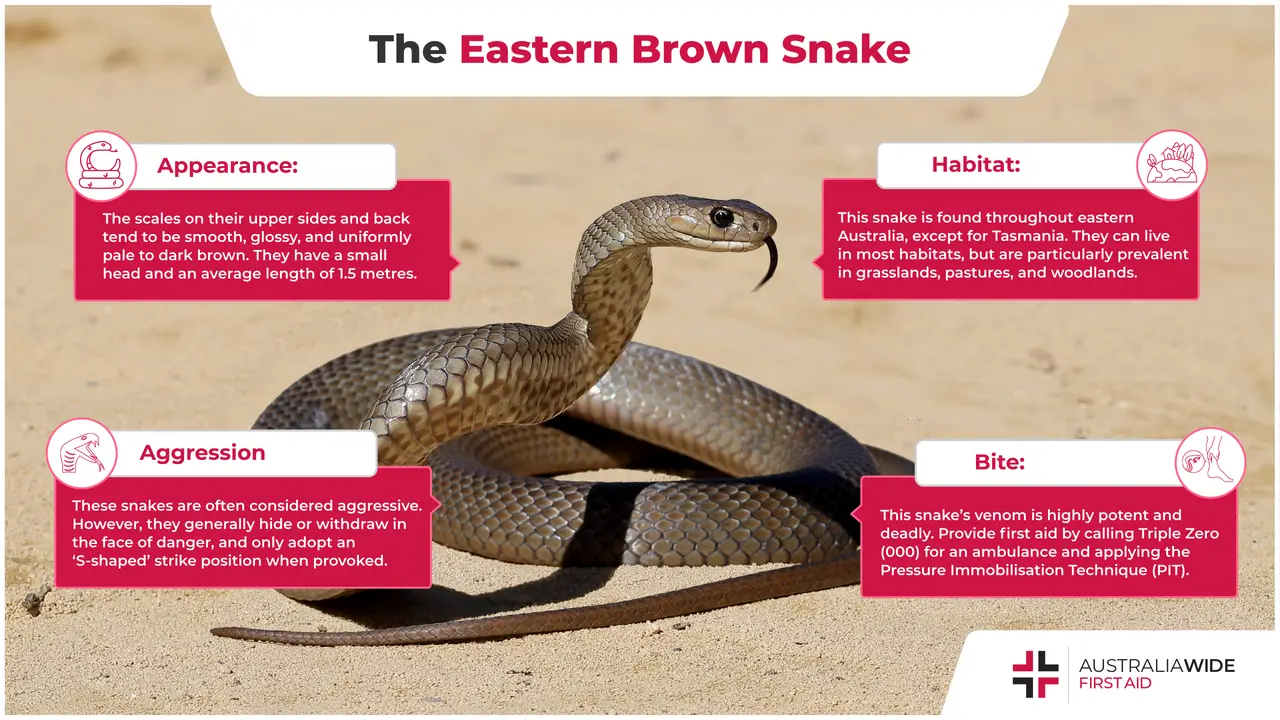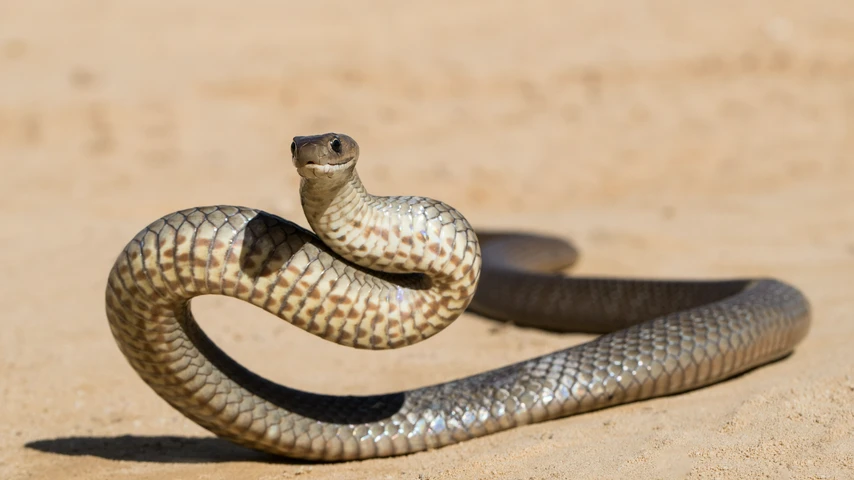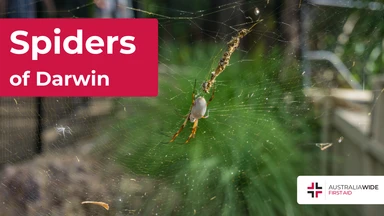Snake Facts: The Eastern Brown Snake


The Eastern brown snake is the second most venomous land snake in the world after the inland Taipan.
This snake is renowned for adopting a defensive ‘S’ shaped strike position when provoked.
Their predators include birds of prey and feral cats. And while they are immune to the venom of the Mulga snake, they are not immune to the venom of the cane toad. In fact, many Eastern brown snakes die after ingesting cane toads and their venom.
In this article, we will cover all the important points that you need to know about the Eastern brown snake, including where they are from, whether we are safe from them, and what to do if one bites you. Let’s get into it!
Also known as the Common brown snake, the Eastern brown snake belongs to the Elapidae family of venomous snakes. The Elapidae family comprises approximately 360 different snake species and more than 170 different subspecies.
Snakes from the Elapidae family are renowned for their permanently erect fangs and a unique threat display, wherein they lift the front part of their body off the ground, flatten their necks and open their mouths.
Eastern brown snakes are medium sized and have a small head. The scales on their upper sides and back tend to be smooth, glossy and a uniform pale to dark brown, though they can also come in black or burnt orange. Their eyes are characterised by an orange iris, a round pupil, and a thick black rim. On average, they are 1.5 metres in length, though the largest Eastern brown snake ever recorded was almost 7 feet long.
They are commonly mistaken for many other snakes, including the Speckled brown snake, Mulga snake and the Taipan.
In the wild, Eastern brown snakes eat mice, rats, birds, frogs, other reptiles and the eggs of other reptiles.
Smaller specimens eat lizards and small reptiles, while larger specimens prey on warm-blooded animals. Eastern brown snakes hunt during the day. However, on very hot days they tend to delay hunting until the evening.
They have good eyesight. Once they find prey, Eastern brown snakes will chase and subdue it with venom and constriction. In captivity, they are known to be cannibalistic and to prey on snakes their own size.
Eastern brown snakes are found all over eastern Australia, from North Queensland to South Australia and western part of the Northern Territory. They are found over most of Queensland, New South Wales and Victoria.
In south-eastern Queensland, the Eastern brown snake is commonly found around Ipswich and Beenleigh. They can adapt to almost every habitat except the rainforest, including dry eucalypt forests, savannahs, grasslands, scrublands and farmlands.
Eastern brown snakes are most commonly encountered in the spring, though they are also active on mild winter days and can sometimes be seen basking in air temperatures as low as 14 degrees Celsius.
We run certified First Aid courses throughout all major Australia citys. Find a location near you.

Eastern brown snakes are solitary in nature – in fact, females and young males prefer not to cross paths with adult males. These snakes move very fast and can even outpace a person running at full speed.
In a study that monitored 455 encounters between Eastern brown snakes and humans, it was found that the snakes advanced in only 12 encounters. For the remaining encounters, they either withdrew or tried to hide.
The snakes’ defensive displays are often mistaken for acts of aggression.
Although the average venom yield is 4mg, it is highly potent. Venom from an Eastern brown snake contains neurotoxins (toxins that are destructive to nerve cells), cardiotoxins (toxins that are destructive to cardiac muscle cells) and nephrotoxins (toxins that are destructive to kidney cells).
If left untreated, a bite from an Eastern brown snake can cause progressive paralysis and excessive bleeding. Many deaths occur due to excessive bleeding in the brain from consumptive coagulopathy, a condition affecting the blood’s ability to clot.
Eastern brown snakes are responsible for an estimated 60% of human snake bite deaths in Australia. It is worthwhile noting, most bites occur when a person attempts to kill the snake, so it’s always best to leave them alone and wait for a professional snake catcher.
Please note, if the bite site is on an area of the body where a pressure bandage cannot be applied, make sure you maintain firm pressure. It is also important that you do not attempt to capture or kill the snake, nor to cut the bite and suck the venom out. More information about the dos and don'ts of snake bite first aid can be found in our Article Library.
Some people can have a severe allergic reaction when bitten by a snake. This is called anaphylaxis, a condition that can be fatal in as little as 15 minutes. Symptoms include:
If the casualty begins exhibiting any of the above symptoms, call Triple Zero (000) for an ambulance, consult the Australian Resuscitation Council's anaphylaxis treatment guideline, and follow DRSABCD and prepare to perform CPR.

To learn how to provide first aid for an Eastern brown snake bite, such as applying a pressure immobilisation bandage and splint, book a First Aid course with Australia Wide First Aid today!
More information about Eastern brown snakes can also be found in our article on common snakes in the greater Brisbane area.

March 11, 2025
Darwin, the tropical capital of Australia’s Northern Territory, is home to a rich diversity of wildlife - including an impressive array of spiders. From the sprawling webs of golden orb-weavers to the cryptic camouflage of trapdoor spiders, these arachnids play a vital role in the local ecosystem. While some may inspire fear, the majority are harmless and even beneficial, helping to control insect populations.

September 4, 2024
Cat bites, while often underestimated, can lead to serious health complications if not treated promptly and properly. Cats' mouths harbour a variety of bacteria that can cause infections in humans.

April 1, 2024
Encounters with wildlife can often be thrilling, but when it comes to the creature known as the drop bear, the experience can quickly turn dangerous. A sharp increase in recent attacks prompts the need for understanding proper first aid procedures in case of an attack.